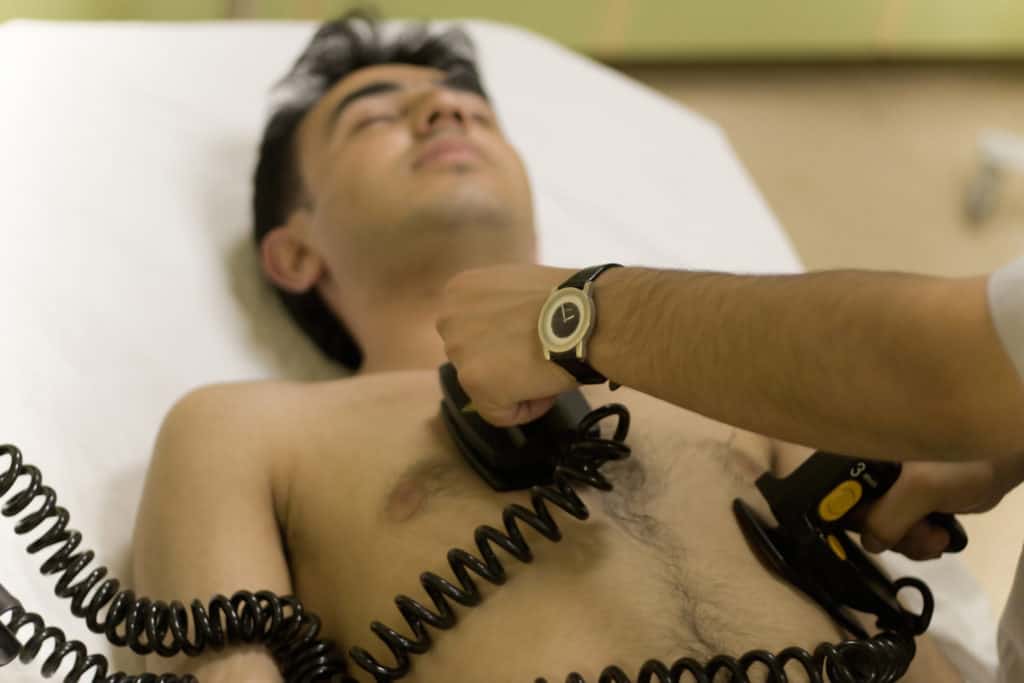Cardioversion
Certain patients who are troubled with atrial fibrillation may be eligible for a procedure called (electrical) cardioversion to try to restore normal heart rhythm. This involves delivering one or more electrical shocks to the chest using metal paddles whilst the patient is under a general anaesthetic. Cardioversion is most successful at restoring sinus rhythm in patients with a structurally normal heart, demonstrated on an echocardiogram, and in whom the abnormal heart rhythm is a new finding.
Atrial fibrillation can cause clots to form within the heart and the shock that is delivered to the chest during a cardioversion may cause any pre-existing clots in the heart to break free and enter the circulation, which could lead to a stroke. As such a patient is required to take an anticoagulant for a few weeks before and after the procedure. Patients may also have a TOE (transoesophageal echocardiogram) immediately prior to the delivery of the shock, to be absolutely sure that there are no clots in the heart despite anticoagulation.
A TOE comprises a miniaturised probe which connects to the main echo machine and it is then positioned in the oesophagus, which lies behind and immediately adjacent to the heart, giving exquisitely detailed images of the heart structures and function. During the cardioversion itself, the patient will be connected to an ECG machine to monitor the heart rhythm, and a brief, controlled shock, usually 200 J, is delivered to the chest via two metal paddles.
The doctor will be able to see immediately if this has restored normal sinus rhythm via the ECG monitor; it is not uncommon, however, for the rhythm to return to normal briefly, and then flip back into AF. If the first shock is ineffective, a further shock will be delivered, and if this still fails to restore sinus rhythm, a third and slightly larger shock, usually 360 J, will also be delivered. At this point, if sinus rhythm has not been restored, the doctor may decide to accept AF as the patient’s normal rhythm moving forward.
Elective cardioversions generally only take about 10 minutes, which includes giving the general anaesthetic immediately beforehand. The patient will be admitted to hospital as a day case and will need to be nil by mouth for four to six hours beforehand because of the anaesthetic, and there is short period of recovery after this. Following the procedure the chest may feel a little sore from the delivery of the shocks, but otherwise it is generally well tolerated. The patient will require observation for a few hours while the effects of the anaesthetic wear off, but will typically be discharged on the same day and should make arrangements to be driven home afterwards.

Related links:
Symptoms - Palpitations, Dizzy Spells and
Blackouts
Palpitations are a common symptom that may or may not signify an important underlying heart problem. Read more
Tests - ECG Monitoring
There are several different types of ECG monitoring, chosen based on symptoms or the condition in question. Read more
Conditions - Atrial Fibrillation
Atrial fibrillation (often abbreviated to “AF”) is a very common heart rhythm disturbance, affecting over a million people in the UK. Read more
Medical Therapy - Atrial Fibrillation
When the atria fibrillate, they no longer contract in a mechanically useful way, causing a degree of stagnation to blood flow and predisposing to clot formation within the chambers, and in particular within a finger-like projection called the left atrial appendage. Read more
Treatments - Ablation
The role of ablation in the treatment of various abnormal heart rhythms has evolved over the last two decades and now has an established place in the management of various arrhythmias, the most common of which is atrial fibrillation. Read more